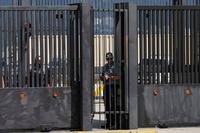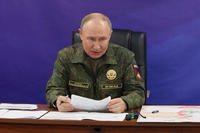The Air Force is moving forward with an amphibious, pontoon-equipped version of the MC-130J Commando II used by its special operators -- and hopes to be able to fly a prototype of the aircraft in less than a year and a half.
A U.S. Special Operations Command official said at a conference in May that the military was considering developing an amphibious MC-130, but that concerns about feasibility meant that the Air Force would take a hard look at the idea before proceeding.
But in a Tuesday press release, Air Force Special Operations Command outlined plans to go ahead with the MC-130J Commando II Amphibious Capability, or MAC, program.
Read Next: What Happens to Soldiers Who Refuse the COVID Vaccine?
AFSOC said that adding removable pontoons to the Commando will be important as the military's focus shifts to areas near seashores or lakes -- and free its aircraft from having to land on physical runways.
The military in recent years has, for example, become concerned about China's increasing activity in the South China Sea, and its creation of man-made islands there on which it has built military installations.
But a Commando that could land on water would be able to do a lot more to infiltrate troops, get them out, and recover trapped or wounded personnel, Lt. Col. Josh Trantham, AFSOC's deputy division chief for science, systems, technology and innovation, said in the release.
That will be even more important in a future war, which might result in situations where land forces, bases or equipment are endangered by the enemy, AFSOC said.
"Seaborne operations offer nearly unlimited water landing zones, providing significant flexibility for the joint force," Trantham said.
The MC-130J is used to fly secret missions, often at night and at low altitudes, to insert special operations forces into sensitive or hostile areas, get them out, or resupply them. It also can conduct aerial refueling operations.
MC-130s are outfitted with extensive electronic warfare capabilities that allow the crews to detect and avoid radar and infrared-guided threats. They have advanced computers and navigation equipment, as well as radars that are specially designed to help the aircraft fly exceptionally low and in harsh weather conditions. And their tails are stronger than the typical C-130 tail to make it easier to conduct high-speed airdrops.
AFSOC has been working with the Air Force Research Laboratory's Strategic Development Planning and Experimentation directorate, as well as defense contractors, on the amphibious modifications.
The prototypes for the modified plane are being tested virtually on the Digital Proving Ground, using digital design, virtual reality modeling and computer-aided designs, AFSOC said. The hope is this will allow the project to use digital simulation, testing and advanced manufacturing to quickly create and test physical prototypes.
"Being able to experiment with existing technology to evaluate design tradeoffs and test a new system before ever bending metal is a game-changer," said Maj. Kristen Cepak, AFSOC's technology transition branch chief, in the press release.
The Air Force's still-in-development T-7A Red Hawk trainer aircraft also heavily used digital tools in its design and engineering process, which the service said allowed it to catch problems earlier than the typical process would permit.
AFSOC hopes it can develop prototypes quickly and possibly fly an experimental version in 17 months.
And if it works, the Air Force hopes to outfit other versions of the C-130 -- including Hercules aircraft flown by other services -- with similar amphibious capabilities, with just a few tweaks.
It wouldn't be the first time a C-130 variant was modified to allow it to land in unusual environments. The New York Air National Guard's LC-130 "Skibird" aircraft, for example, is outfitted with skis and rockets to help it land on and take off from icy Antarctic surfaces on missions to resupply scientific stations there.
-- Stephen Losey can be reached at stephen.losey@military.com. Follow him on Twitter @StephenLosey.
Related: AFSOC 'Moving Away' from Selecting Operators Based on Physical Performance












